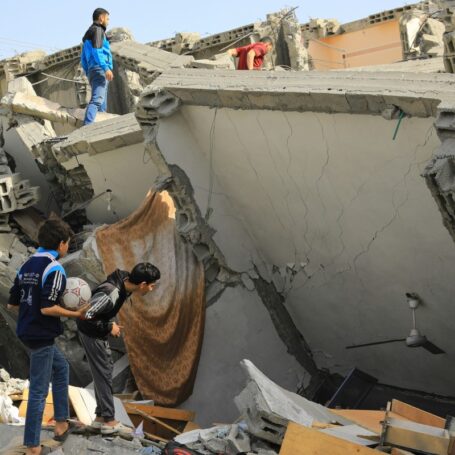Solidarity In the Midst of COVID: Excerpt from ‘Together Apart’
Pandemics inspire the most remarkable acts of unity and compassion (Solnit, 2009). They also lead to appalling acts of division and brutality (Cohn, 2018). The question for this chapter is why and when we come together, rather than fall apart, in crises such as the COVID-19 pandemic. As with all human behaviour, multiple processes at multiple levels are involved. Some involve individual characteristics such as personal sensitivity towards justice and individual orientations towards prosocial values, or demographic characteristics such as gender, age and income — all of which have been found to be associated with the likelihood of people exhibiting prosocial behaviours (e.g., Zagefka & James, 2015).
However, the problem with trying to explain behaviour in terms of relatively stable individual differences is that these cannot explain the rapid surge of solidarity (and sometimes, hatred) in a crisis. It is here that group-level explanations come into their own. Research shows that people are more prone to help and empathise with individuals who are perceived as members of the same group than those who are perceived as outgroup members. For instance, Levine and colleagues (2005) took fans of Manchester United and emphasised their club allegiance. These fans then witnessed someone falling over and hurting themselves. This person was either wearing a Manchester United shirt, a Liverpool shirt (both red) or a plain red t-shirt. Participants tended to help the first of these — their fellow Manchester United fan — much more often than the other two.
Collective solidarity is rooted in shared social identity
The fans behaved as they did due to the relational shift that occurs when we have a sense of shared identity with others (a point first discussed in Chapter 2). This flows from the core premise of the social identity approach: that the self is not just about ‘me’ (and what makes me distinctive) but about ‘we’ (and what makes my group distinctive). At the group level, this means that what happens to other group members literally happens to my (extended) self. Their fate is my fate. Their sorrows are my sorrows. An insult to one is an injury to all. Hence, I help them in the same way that, as an individual, I help myself. In short, whether I show solidarity to others or not turns on whether I share social identity with them (Yzerbyt & Phalet, 2020).

But we have only told half the story of Levine’s Manchester United study. A second condition was run, identical to the first in every respect bar one. The difference was that this time, stress was not on participants’ specific fan identity (as supporters of Manchester United), but on the fact that they were football fans. Again, Manchester United fans witnessed someone wearing a Manchester United, Liverpool, or plain red shirt fall down and hurt themselves. However, in this condition, they helped the injured individual wearing either the Manchester United or the Liverpool shirt, but not the person in the plain red t-shirt. While they were still just helping ingroup members, here their identity was more inclusive (as football fans rather than fan of a specific football team), so their solidarity was extended to more people. Those who might otherwise have been seen as rivals to oppose became comrades to whom succour was given (a point we return to in Chapter 20).
The critical point here is that group membership is not a given. It is dynamic and subjective. In different situations, we may see ourselves as individuals or as group members; we may adopt different group memberships in which we share identity with more or less people; and we may define the same group (e.g., the nation) more or less inclusively (see Chapter 2). We can now take a further step in our quest to understand why and when people behave selfishly, or else cooperatively, in a crisis. If solidarity depends upon shared identity in a group, and group membership is variably defined, our task becomes one of understanding how these definitions come about when disaster strikes.
Solidarity is a function of history, context and leadership
Our discussion of how groups are defined in a disaster links up with general discussions we have had about the nature of social identity processes throughout the book thus far — notably in Chapter 2 where we discussed the social identity approach, and in Chapter 3 where we discussed leadership. Consistent with those discussions, when it comes to understanding solidarity, we propose three broad determinants of category definitions: history, contemporary context, and leadership.
In terms of history, communities that prove to be resilient in the face of disasters are those characterised by strong and dense pre-existing networks, as well as norms of trust and reciprocity. Such networks are related to increased preparedness before disasters (Reininger et al., 2013), greater solidarity during disasters (Aldrich, 2017), and improved recovery after disasters (Aldrich, 2012).
However, community and communal solidarity can also emerge spontaneously in the immediate context of a crisis, and combine to mobilise solidarity and social support. This can be put down to the experience of ‘common fate’ in the face of mortal danger. To some extent, everyone faces the same problems both during a disaster and in its aftermath (Ntontis, 2018). Survival depends upon everyone pulling together and so the disaster becomes about the group, not the individual (Ntontis et al., 2019). Evidence from a range of different disasters in different countries (Drury et al., 2018) confirms the link between a sense of shared fate and shared social identity, and also between emergent social identity and solidarity.
The third factor that determines shared identity and solidarity, as discussed in Chapter 3, is leadership and the language that leaders use. Within this pandemic, we have seen a broad range of leadership performance from those (such as Jacinda Ardern in New Zealand and Nicola Sturgeon in Scotland) who consistently framed COVID-19 as affecting a broad and inclusive national community. In contrast, others (such as Narendra Modi in India and Donald Trump in the U.S.) divided the community, and blamed segments of their country for both the disease itself and for their response to it.
However, good leadership is about more than rhetorical inclusion. It is also about implementing the policies which unify people in practice. It involves addressing the huge inequalities which mean that we are not all in this together. The destitute, the marginal, and the oppressed are far less able to protect themselves from COVID-19, and are consequently getting infected and dying at far higher rates. In more affluent countries, wealthier people are better able to stay at home than poorer people who need to go out and work (Valentino-DeVries et al., 2020) — that is if you have a home in the first place. Homeless people cannot self-isolate (see also Chapter 17). Maintaining a sense of common cause, of shared identity and of solidarity at national and international levels is severely compromised unless leaders address these issues.
Group membership and solidarity are fragile and require long-term investment
Just like journalists, who descend on a disaster at its height and then generally ignore what happens in the aftermath, so researchers tend to concentrate on what happens in disasters, not after disasters. But some researchers have taken a longer-term perspective and asked the question ‘does the sense of togetherness and solidarity endure over time’? This question is critical because often the greatest problems (such as loss of social networks and livelihoods) are those that emerge long after the immediate drama of a fire or a flood (or a pandemic) has ebbed away (Schonfeld & Demaria, 2015). It is in response to these many problems that groups and solidarity are most important — both for practical reasons and also to maintain the mental and physical well-being of the community (as discussed in Section C).
Common fate and leadership are critical in determining solidarity in a disaster, and are equally critical in ensuring the persistence of solidarity in its aftermath. Research on a flood-hit area 18 months after the disaster showed that inequalities in the post-disaster treatment of different groups and the return of pre-disaster group boundaries undermined any sense of common fate (Ntontis et al., 2020; see also Chapter 17). However, this decline is not inevitable. The persistence of secondary stressors (to the extent that they are perceived in collective terms) and of equitable social support can help maintain shared social identity. This can also be actively sustained by regular collective rituals such as commemorative events (Norris & Kaniasty, 1996).
In summary, we have sought to make two main points in this chapter. First, solidarity in a crisis like COVID-19 is a function of shared social identity. Second, shared social identity is a function of the creation of inclusive social categories — and whether this happens depends on history, contemporary context and leadership. But what should those tasked with responding to crises — and specifically to pandemics and other health crises — actually do? That is what we discuss in the next chapter.
Explore This Theme
Introduction to Collective Behaviour
Crowds | Fergus Neville and Stephen D. Reicher
An outline of both traditional and contemporary models of collective behaviour.
Emergencies and disasters | John Drury and Selin Tekin Guven
How people behave in crises, mapping the emergence of widespread solidarity
Solidarity | Evangelos Ntontis and Carolina Rocha
Exploring the psychological underpinning of such solidarity, providing evidence for the critical role of shared social identity.
Managing crowds in crises | Holly Carter, Dale Weston and Richard Amlôt
Looking at emergency services and their relation with the public
Social order and disorder | Clifford Stott and Matt Radburn
Examining the nature of police–public encounters in determining whether the public stay united and orderly



























































































